|
Repeat Performance of Johnson Effect (12/1/2007) (Click images to expand them.)
The third test flight by Dick Johnson in Caddo Mills, Texas, on 12/13/2006
produced such extortionary results that Dick threw it out of his analysis and no one had a mind
to give it a second thought. For three months, I studied that and other "anomalies" in the Johnson data,
then argued that they were real. Now, Johnson's third flight has been duplicated!
On Saturday, 12/1/07, the same glider, with redesigned deturbulators, essentially duplicated Johnson's third flight.
His best L/D was an astounding 64:1, a 90% increase. The new measurement was 56:1, a 67% increase.
Unbelievable as this seems, these figures are consistent with Dr. Sinha's objective and now the reality of this
achievement can no longer be ignored. Extreme performance is both possible and repeatable!
Note: All large glide ratio vales contain large uncertainties. They should be taken as approximate values.
However, the magnitude of these performance increases dwarfs those uncertainties.
Following are the altitude vs. time profiles for both flights taken from a Cambridge 302 flight data recorder. Notice how both
profiles flatten out at the start of the 50 kt speed run and return to a poor sink rate after the 50 kt run. Those points are highlighted
with blue lines.
|
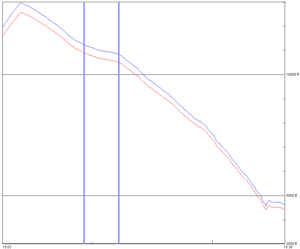 Johnson Flight #3 - 12/13/2006
Johnson Flight #3 - 12/13/2006
|
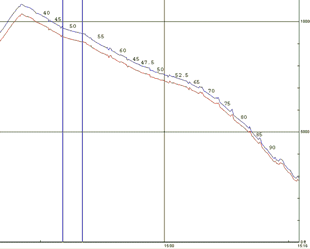 Hendrix Flight - 12/1/2007
Hendrix Flight - 12/1/2007
|
Following are the two glide ratio plots superimposed.
Notice the close replication of the Johnson data from 40 kts to 60 kts. This validates our different measurement
techniques and the pristine atmospheric conditions on the test dates.
|
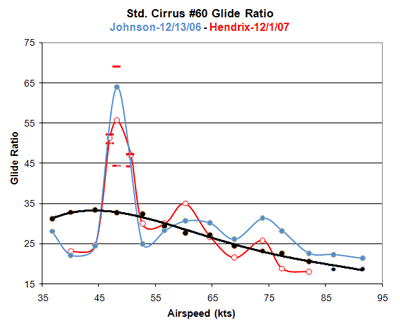
|
|
|
|
|
Now I present some oil flow patterns taken on 11/17/2007. After a failed test with the same deturbulators, I took these
oil flows and used them to indicate a configuration of tapes that might lead to positive performance improvements. The
next flight on 12/1/2007 reversed the earlier losses and duplicated Johnson's amazing flight a year earlier. Anyone familiar
with such patterns will immediately see that there is no evidence of normal attached turbulent flow on the aft part of the
wing where it should be. Likewise, on the front of the wing, the flow pattern is unusual. On a normal wing, these
patterns would be drastically different, with laminar flow on the front of the wing rubbing the oil clean then leaving
some on the surface as it lift away from the surface only to return in the region of the deturbulator, with a circulation
pattern that traps much of the oil in a circulation region just forward of the deturbulator strip. Behind that, the oil
would be gathered in streams by the attached turbulent flow. However, in these flows, the oil in both areas appears to have
been only gently nudged aft, but not enough to produce significant streaming. Clearly, we have achieved a thinly separated
flow over most of the upper wing surface that virtually eliminates skin friction drag.
These images show inner and outer panel sections (different airfoils) after a pattern tow and landing at 50 kts. Seals
over the aileron gaps are purposely omitted. However, inner S-seals are installed and the lower gaps have curved mylar seals.
|
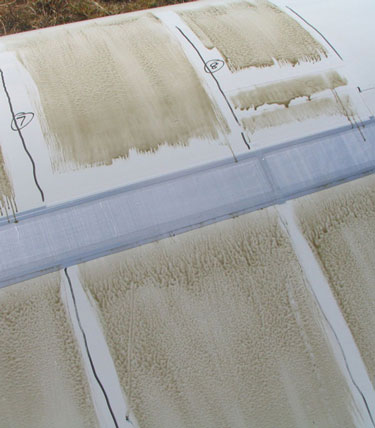
|
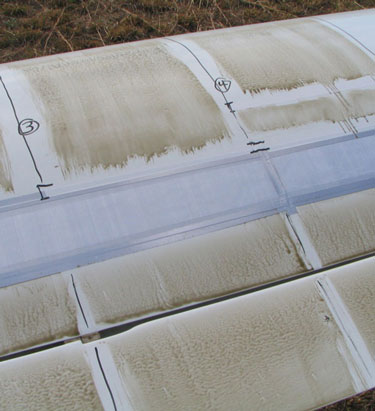
|
Following is a normal oil flow. Notice the sharply defined transition bubble circulation zone.
Contrast the stringy runs of oil with the gently pushed patterns in the images above.
|
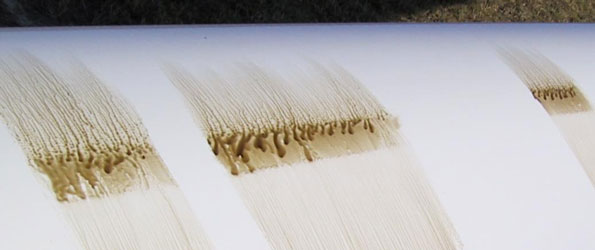
|
Following are Johnson's 12/13/2006 and my 12/1/2007 flight logs. You are free to download them to analyze as you please.
Johnson's airspeed segments may be isolated by referencing indicated pressure altitudes in the table below.
My segments were separated by "notching the barograph," as it were, and are also labeled in the top right image (above).
Johnson's flight is the second one in his log file.
| File |
Date |
Place |
Pilot |
| 6CDC3R22.IGC |
12/13/2006 |
Caddo Mills, Texas |
Johnson |
| 7C1C3R24.IGC |
12/1/2007 |
Cherry Valley, Arkansas |
Hendrix |

One last point. I choose to call this phenomenon (a slightly separated boundary flow that essentially eliminates skin friction
to yield extraordinary performance improvements) the "Johnson Effect, after the first pilot to demonstrate it
in flight." Hence the title of this article.
Jim Hendrix
|
|